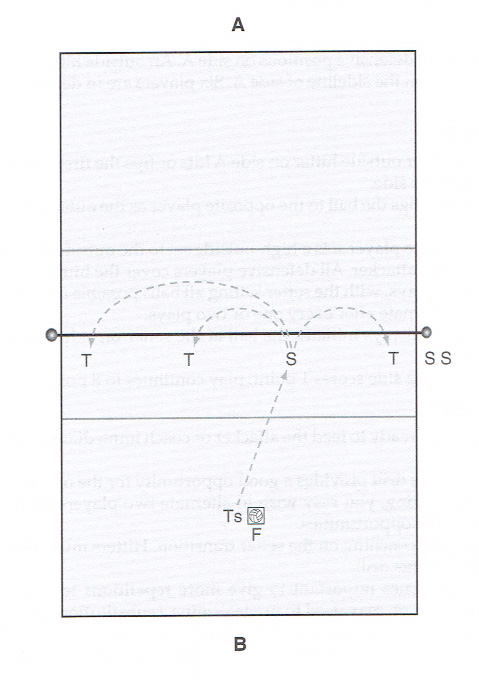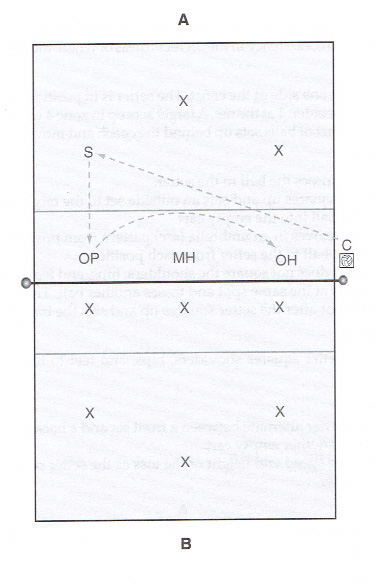| Setting Drills |
| By: Teri Clemens and Jenny McDowell
Originally Published in: The Volleyball Drill Book Provided by: Human Kinetics Because the setter must be prepared to send the ball in either direction, this drill reinforces the importance of receiving the ball at the same location above the forehead. It also adds a mental aspect to a physical repetition drill. Purpose To practice adjusting to last-minute directions to set the ball. Setup A setter gets into position at the net in zone 6 on side A. The coach stands in the middle back with a basket of balls on side A. Targets are in zones 1 and 9 with the empty ball carts. Run the Drill 1. The coach tosses a ball to the setter positioned in zone 6 at the net. 2. The coach calls out "front" or "back" before the ball reaches the setter. 3. The setter either sets a front 4 or a back 9, depending on the call. 4. The setter tries to set 24 balls in the correct direction. Coaching Point As the setter improves, delay the call to challenge the setter. Variations • Add a live passer. • Replace the call with a middle blocker who makes a step in one direction so that the setter must set in the opposite direction.
SETTER FOOTWORK CHALLENGE This is a basic but critical drill. Players sprint to the net 24 times-8 from right back, 8 from middle back, and 8 from left front (zones 1, 6, and 4 respectively)—and set 24 outside sets (4s). Purpose To improve footwork to the net out of the serve-receive patterns and improve the consistency of the sets. Setup A coach sets up on side A in the middle-back area with a basket of balls and a feeder. Setter 1 is in the right back with setter 2 behind her or him. Setter 3 is in the left front ready to catch the set. Run the Drill 1. The coach tosses the ball to setter 1, who has sprinted to the net and is setter ready in zone 6 along the net. 2. Setter 1 sets the 4 ball, covers, and becomes the next catcher. 3. Setter 3 catches setter l's set and sprints to the coach, hands the ball to the coach, and sprints to the end of the line to set. 4. Setter 2 runs to the net to set after setter 1 has completed her or his set. 5. Each setter sets eight times from the right back, then the group of setters moves to the middle back for eight repetitions each. The group then moves to the left front for eight repetitions each. Coaching Points • Insist on a full-out sprint to the net on each repetition. • Give feedback on the consistency of each set. Variations • Change the locations for where the setter starts. • Alter the type of sets the setter will perform.
SETTER TRANSITION REPETITION Purpose To give the setter the opportunity to dig, transition, cover the hitter, and finally to transition to set the outside hitter. Setup Six players are in defensive positions on side A. An outside hitter or coach with a cart of balls is on the sideline of side A. Six players are in defensive positions on side B. Run the Drill 1. The coach or outside hitter on side A hits or tips the first ball at the setter on the same side. 2. The setter digs the ball to the opposite player as the outside transitions to attack. 3. The opposite player sets a high-outside set to the outside hitter or a set to the middle attacker. All defensive players cover the hitter. 4. The rally plays, with the setter setting all balls possible after the first ball. 5. Setters alternate after every one or two plays. 6. The coach always initiates the ball at the setter on side A after the rally has ended. 7. The winning side scores 1 point; play continues to 8 points. Coaching Points • Have a ball ready to feed the attacker or coach immediately after the rally ends. • Because this drill provides a good opportunity for the opposite player to practice setting, you may wish to alternate two players in that position to share the opportunities. • Focus your coaching on the setter transition. Hitters must also transition quickly in this drill. • It is sometimes important to give more repetitions to one setter over another, so you may need to predetermine a substitution ratio or routine. For example, you could give the starting setter three plays and the second setter two plays, maintaining that sequence throughout the drill. Variation Initiate play with a toss over the net to side B, who must pass, set, and attack the setter in the right-back position on side A. This adds a specific dimension for side B, but keeps focus on the setter transition on side A.
|











